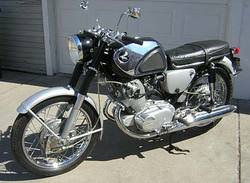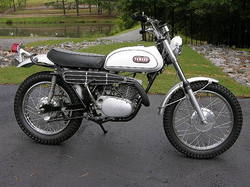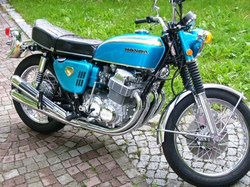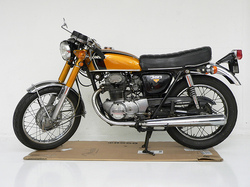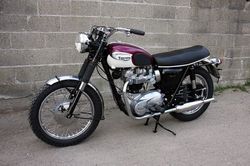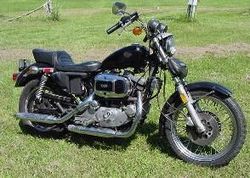(V) FROM 1962 TO AROUND 1980:
From the rise of the Japanese motorcycle industry, to the fall of the British motorcycle industry, to the near failure of the American industry:
From the early 1960's, beginning with Honda, there was a Japanese motorcycle invasion. Honda's famous advertisement "you meet the nicest people on a Honda" signaled a big change. Motorcycles in the US had been for the hard core "bikers". Few regular people rode motorcycles. They were oily, loud, required ongoing maintenance, and were largely associated with a rougher crowd. I have heard of stories where motorcyclists were denied motel rooms or resturant seating because they were on motorcycles. The Japanese invasion changed that. In the early 60's, there were around 30,000+ motorcycles imported to the US every year. By the late 60's the numbers soared to over two million per year. The British bikes never went much over 50,000 bikes imported annually, the Japanese bikes accounted for the larger figures. The numbers were staggering! Bikes were now ridden by the masses. Furthermore, the Japanese bikes were fast for their size, reliable, and inexpensive. Motorcycling became another American pastime. There was still the old "biker" crowd, but now there was an entire generation buying 50cc bikes, moving up to 175's, then 250/350's, then the big bikes! Most of the new riders stayed with the Japanese machines because they were less intimidating and user friendly.
The Super Hawk shown below sold in the hundreds of thousands:
Suzuki, Yamaha, Kawasaki, and Brigestone were also importing to the US by 1963, but Honda sold bikes 10 to 1 to theirs. The Super Hawk's and Scrambler's were seen everywhere. There were reasons for the high Honda sales, the Honda's were 4 strokes (the 2 strokes required the mixing of gas and oil till around 1966), most Honda's had electric starters, they were stone reliable (many of the 2 strokes would freeze up under heat or poor mixing of oil and gas), and had a nice sound.
The huge numbers of 50cc through 305cc Honda's sold after 1963 was the catalyst for the 1960's motorcycle revolution.
The Kawasaki Samauri 250:
The 250cc Kawasaki would run away from the 305 Honda Super Hawk. They were very fast and also attractive. New riders feared the 2 strokes because of their on/off power characteristics.
Below is a 1968 Yamaha DT 1:
The Japanese revolution also changed the off road bikes. The little DT1 (250cc) could outrun the British 500cc machines by the late 1960's, if set up for competition. They were light, fast, and handled very well!
The mighty CB750 changed motorcycling forever!
The Triumph Trident and BSA Rocket 3 came out a few months before the Honda 750 but they looked antiquated compared to the Honda. The Honda had 4 cylinders, overhead cams, a 5 speed transmission, disc brakes, and was less tempramental than the British bikes. The Honda outsold the British bikes by huge numbers, was considered the first super bike, and didn't leak oil. The Honda was also an electric starting machine costing about the same as the British 650's. Most motorcycle historians credit the Honda 750 as the bike which ushered in the modern motorcycle. The CB750 is still a modern bike today!
The Honda CB350 sold in the millions:
Below is a 1970's Triumph Bonneville.
The British companiesa failed for numerous reasons:
1. they didn't invest in new technology but just re-vamped old designs;
2. when they did come out with new machines, they were little different from the older machines. The Trident and Rocket 3 were not well accepted by the motorcycle consumer and not purchased because of looks alone;
3. they failed to market to the younger croud or to build their business on new buyers;
4. while Japaneese dealers had showrooms filled with new bikes, a Brit bike dealer might have just a few bikes;
5. the cost of production for the British bikes was considerably greater than the Japaneese counterparts. A honda CB350 cost about the same as a BSA Starfire 250 single. The Brit bikes were overpriced with no hope of lowering them;
6. most of the Japanese dealers were in bright, new, and clean showrooms while so many of the British dealers were still selling from outdated, dirty, and old school looking shops which were not attreactive to the masses;
7. the Japaneese bikes were very reliable, the Brits and Harley Davidson's were known for being unreliable and high maintenance;
8. all of the Japaneese bikes (up till 1965) were small bikes (under 450cc) and the British builders didn't realize the threat of direct competition. When the CB750 arrived, they were dead in the water within three years.
Harley Davidson continued as America's primary motorcycle manufacturer. From 1969 to 1981 the company was owned by AMF (the bowling equipment company). During that time period Harley experienced a great deal of trouble and nearly went bankrupt. During those years Harley became known as a poorly built, unreliable motorcycle. The "corporate" style management system does not work well with motorcycles. Several investors purchased the company from AMF (including Willie G. Davidson) for $80 million dollars and brought it back from the dead. During the mid 1980's and after, Harley was more then revived, it became an American icon.
Key traits of this period in motorcycle history:
1. By the mid 1960's there was a Japanese motorcycle invasion which transformed the industry in many ways (sales numbers, reliability, innovation, & performance);
2. The demise of the British motorcycle empire begins and is over by the early 1970's;
3. The Japanese take on the big bike makers and win;
4. The 2 stroke engine has it's day (from the mid 1960's) but is out by the early 1970's;
5. Harley Davidson looses it's way and nearly goes bankrupt. It is revived by the mid 1980's;
6. There is a huge growth in the "off road" motorcycle market;
7. The "super bike" is introduced (Honda CB750 & Kawasaki Mach I) and continues today;
